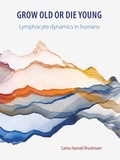Grow old or die young
Lymphocyte dynamics in humans

Bruckmaier, Carina
- Promoter:
- prof. dr. J.A.M. (José) Borghans
- Co-promoter:
- dr. N.A. (Kiki) Tesselaar
- Research group:
- Borghans Tesselaar
- Date:
- June 3, 2024
- Time:
- 14:15 h
Summary
In this thesis, we explore the dynamics, T-cell receptor (TCR) diversity and functional characteristics of lymphocytes in various (tissue) sites in homeostasis and during imbalanced states. While natural killer cells stand out as an interesting cell type for cancer cell therapy as a therapeutic tool, researchers have questioned whether they may be too short-lived to be effective in the long term. Thus, our aim was to determine the lifespan of natural killer cells which we estimated to be 94 days — longer than previously reported in the literature. Shifting our focus to T cells, particularly memory T cells residing in tissues of wildling mice and humans, we examine the differences in their lifespan across various tissue sites compared to their counterparts in blood. This approach challenges the current notion that tissue-resident memory T cells are long-lived, revealing that they are, contrary to common belief, not longl-ived. Furthermore, our studies shed new light on the ongoing debates regarding the lifespan of Treg cells, suggesting that during adulthood their maintenance is mostly independent of thymic output. Additionally, we investigate the impact of aging and neonatal thymectomy on the functional characteristics and TCR repertoire diversity of naive and memory T-cell populations in adulthood. Despite being a topic of intense debate, our study shows that thymectomized individuals seem to not age prematurely. Instead, they have a TCR repertoire that is as diverse as that of age-matched individuals.
By understanding the functionality, dynamics, and diversity of lymphocytes throughout the body, we will not only improve our understanding of the immune system in health and disease, but also pave the way for the development of novel therapeutic approaches.